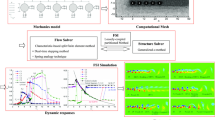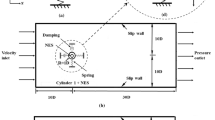Abstract
We present a stability analysis to investigate the underlying fluid–structure modes during transverse wake-induced vibration (WIV) of an elastically mounted downstream cylinder in a tandem arrangement at low Reynolds number. The upstream cylinder with an equal diameter is kept stationary, whereas the downstream cylinder in the tandem arrangement is free to vibrate in the transverse direction. The WIV involves complex interaction dynamics of the upstream wake with the freely vibrating downstream cylinder, which leads to a relatively large transverse force and vibration in the post-lock-in region. We consider a data-driven model reduction approach to construct an eigenvalue representation of WIV system and perform the stability analysis to examine the underlying process of WIV for the tandem circular and square cylinders. The model reduction of the fluid system is constructed by the eigensystem realization algorithm (ERA) and coupled with a transversely vibrating bluff body in a state-space format. Unlike the wake-oscillator model, the ERA-based ROM does not rely on any empirical formulation and captures naturally the essential linear fluid dynamics through the solution of the Navier–Stokes equations. Results show that the WIV region and the onset reduced velocity can be predicted accurately by tracing the eigenvalue trajectories of the ERA-based low-dimensional model for a range of reduced velocities. The stability analysis reveals that there exists a persistently unstable eigenvalue branch that sustains WIV, which also implies that the highly nonlinear behavior of WIV has its linear origin. The sharp corner of the square cylinder is found to have the stabilizing effects, namely (i) the reduced velocity for the WIV onset is larger than its circular cylinder counterpart, (ii) the transverse response amplitude and the lift force are consistently lesser in both lock-in and post-lock-in regimes for the square cylinder configuration. This work has a potential impact on the development of control strategies for reducing undesired vibrations and loads in flexible structures undergoing wake interference effects.


















Similar content being viewed by others
References
Assi, G.R.S., Bearman, P.W., Carmo, B.S., Meneghini, J.R., Sherwin, S.J., Willden, R.H.J.: The role of wake stiffness on the wake-induced vibration of the downstream cylinder of a tandem pair. J. Fluid Mech. 718, 210245 (2013)
Assi, G.R.S., Bearman, P.W., Meneghini, J.R.: On the wake-induced vibration of tandem circular cylinders: the vortex interaction excitation mechanism. J. Fluid Mech. 661, 365401 (2010)
Barkley, D., Henderson, R.D.: Three-dimensional floquet stability analysis of the wake of a circular cylinder. J. Fluid Mech. 322, 215241 (1996)
Bearman, P.W.: Circular cylinder wakes and vortex-induced vibrations. J. Fluids Struct. 27(5), 648–658 (2011)
Bernitsas, M.M., Raghavan, K., Ben-Simon, Y., Garcia, E.M.: Vivace (vortex induced vibration aquatic clean energy): a new concept in generation of clean and renewable energy from fluid flow. J. Offshore Mech. Arct. Eng. 130(4), 041–101 (2008)
Bokaian, A., Geoola, F.: Wake-induced galloping of two interfering circular cylinders. J. Fluid Mech. 146, 383415 (1984)
Dai, H.L., Abdelkefi, A., Wang, L.: Piezoelectric energy harvesting from concurrent vortex-induced vibrations and base excitations. Nonlinear Dyn. 77(3), 967–981 (2014)
Giannetti, F., Luchini, P.: Structural sensitivity of the first instability of the cylinder wake. J. Fluid Mech. 581, 167–197 (2007)
Hobbs, W.B., Hu, D.L.: Tree-inspired piezoelectric energy harvesting. Journal of Fluids and Structures 28, 103–114 (2012)
Igarashi, T.: Characteristics of the flow around two circular cylinders arranged in tandem: 1st report. Bull. JSME 24(188), 323–331 (1981)
Jaiman, R.K., Geubelle, P., Loth, E., Jiao, X.: Transient fluid–structure interaction with non-matching spatial and temporal discretizations. Comput. Fluids 50, 120–135 (2011)
Jaiman, R.K., Pillalamarri, N.R., Guan, M.Z.: A stable second-order partitioned iterative scheme for freely vibrating low-mass bluff bodies in a uniform flow. Comput. Methods Appl. Mech. Eng. 301, 187–215 (2016)
Juang, J.N., Pappa, R.S.: An eigensystem realization algorithm for modal parameter identification and model reduction. J. Guidance 8(5), 620–627 (1985)
Kou, J., Zhang, W., Liu, Y., Li, X.: The lowest Reynolds number of vortex-induced vibrations. Phys. Fluids 29(4), 041–701 (2017)
Li, X., Zhang, W., Gao, C.: Proximity-interference wake-induced vibration at subcritical \(Re\): mechanism analysis using a linear dynamic model. Phys. Fluid 30, 033606 (2018)
Mehmood, A., Nayfeh, A.H., Hajj, M.R.: Effects of a non-linear energy sink (NES) on vortex-induced vibrations of a circular cylinder. Nonlinear Dyn. 77(3), 667–680 (2014)
Meliga, P., Chomaz, J.: An asymptotic expansion for the vortex-induced vibrations of a circular cylinder. J. Fluid Mech. 671, 137–167 (2011)
Morzyski, M., Noack, B.R., Tadmor, G.: Global flow stability analysis and reduced order modeling for bluff-body flow control. J. Theor. Appl. Mech. 45(3), 621–642 (2007)
Mussa, A., Asinari, P., Luo, L.: Lattice Boltzmann simulations of 2D laminar flows past two tandem cylinders. J. Comput. Phys. 228, 983–999 (2009)
Mysa, R., Law, Y., Jaiman, R.: Interaction dynamics of upstream vortex with vibrating tandem circular cylinder at subcritical Reynolds number. J. Fluids Struct. 75, 27–44 (2017)
Mysa, R.C., Kaboudian, A., Jaiman, R.K.: On the origin of wake-induced vibration in two tandem circular cylinders at low Reynolds number. J. Fluids Struct. 61, 76–98 (2016)
Noack, B.R., Afanasiev, K., Morzyński, M., Tadmor, G., Thiele, F.: A hierarchy of low-dimensional models for the transient and post-transient cylinder wake. J. Fluid Mech. 497, 335–363 (2003)
Noack, B.R., Stankiewicz, W., Morzyski, M., Schmid, P.J.: Recursive dynamic mode decomposition of transient and post-transient wake flows. J. Fluid Mech. 809, 843872 (2016)
Pastoor, M., Henning, L., Noack, B., King, R., Tadmor, G.: Feedback shear layer control for bluff body drag reduction. J. Fluid Mech. 608, 161–196 (2008)
Sarpkaya, T.: A critical review of the intrinsic nature of vortex-induced vibrations. J. Fluids Struct. 19(4), 389–447 (2004)
Schatz, M.F., Barkley, D., Swinney, H.L.: Instability in a spatially periodic open flow. Phys. Fluids 7(2), 344–358 (1995)
Schmid, P.J.: Dynamic mode decomposition of numerical and experimental data. J. Fluid Mech. 656, 5–28 (2010). https://doi.org/10.1017/S0022112010001217
Sun, X., Wang, S.Z., Zhang, J.Z., Ye, Z.H.: Bifurcations of vortex-induced vibrations of a fixed membrane wing at \(Re \le 1000\). Nonlinear Dyn. 91(4), 2097–2112 (2018)
Wang, Z., Akhtar, I., Borggaard, J., Iliescu, T.: Two-level discretizations of nonlinear closure models for proper orthogonal decomposition. J. Comput. Phys. 230(1), 126–146 (2011)
Wang, Z., Akhtar, I., Borggaard, J., Iliescu, T.: Proper orthogonal decomposition closure models for turbulent flows: a numerical comparison. Comput. Methods Appl. Mech. Eng. 237–240, 10–26 (2012)
Williamson, C.H.K., Govardhan, R.: Vortex-induced vibrations. Annu. Rev. Fluid Mech. 36, 413–455 (2004)
Williamson, C.H.K., Roshko, A.: Vortex-induced vibrations. J. Fluids Struct. 2, 355–381 (1988)
Yao, W., Jaiman, R.K.: Feedback control of unstable flow and vortex-induced vibration using the eigensystem realization algorithm. J. Fluid Mech. 827, 394414 (2017)
Yao, W., Jaiman, R.K.: Model reduction and mechanism for the vortex-induced vibrations of bluff bodies. J. Fluid Mech. 827, 357393 (2017)
Zdravkovich, M.: The effects of interference between circular cylinders in cross flow. J. Fluids Struct. 1(2), 239–261 (1987)
Zhang, W., Li, X., Ye, Z., Jiang, Y.: Mechanism of frequency lock-in in vortex-induced vibrations at low Reynolds numbers. J. Fluid Mech. 783, 72–102 (2015)
Zhou, Y., Yiu, M.: Flow structure, momentum and heat transport in a two-tandem cylinder wake. J. Fluid Mech. 548, 17–48 (2005)
Acknowledgements
This work has been supported by the Singapore Maritime Institute through Deepwater Grant SMI-2014-OF-04.
Author information
Authors and Affiliations
Corresponding author
Ethics declarations
Conflict of interest
The authors declare that they have no conflict of interest concerning the publication of this manuscript.
Appendix A: Fluid-Structure Energy Transfer
Appendix A: Fluid-Structure Energy Transfer
Following our previous work on VIV [34], the displacement and lift coefficient can be obtained for the linear FSI system as:
where \(\lambda =\lambda _r+i\lambda _i\) is eigenvalue with real \(\lambda _r\) and imaginary \(\lambda _i\) components, \({\hat{Y}}\) and \(\hat{C_l}\) denote the magnitudes of eigenmodes. The phase angle difference is derived by plugging Eq. (A.1) into Eq. (12):
Refer to [34] for further details. Next, the energy transfer per cycle is evaluated as:
Using Eq. (A.3), the energy transfer coefficient \(E_c\) can be defined by excluding the exponential growth/decay rate \(\lambda _r\)
Rights and permissions
About this article
Cite this article
Yao, W., Jaiman, R.K. Stability analysis of the wake-induced vibration of tandem circular and square cylinders. Nonlinear Dyn 95, 13–28 (2019). https://doi.org/10.1007/s11071-018-4547-9
Received:
Accepted:
Published:
Issue Date:
DOI: https://doi.org/10.1007/s11071-018-4547-9




